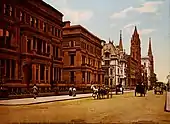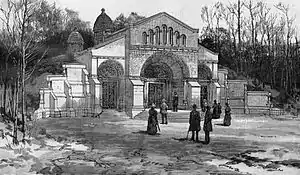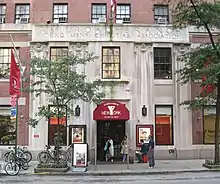William Henry Vanderbilt | |
|---|---|
 | |
| Born | May 8, 1821 |
| Died | December 8, 1885 (aged 64) Manhattan, New York City, U.S. |
| Burial place | Vanderbilt Family Cemetery and Mausoleum, Staten Island, New York, U.S. |
| Education | Columbia College (1841) |
| Occupation(s) | Owner of the New York Central Railroad and other railroads. |
| Political party | Republican |
| Spouse |
Maria Louisa Kissam (m. 1841) |
| Children | Cornelius II, Margaret, Allen, William, Emily, Florence, Frederick, Eliza, and George II |
| Parent(s) | Cornelius Vanderbilt Sophia Johnson |
| Relatives | See Vanderbilt family |
| Signature | |
William Henry Vanderbilt (May 8, 1821 – December 8, 1885) was an American businessman and philanthropist.[1] Known as "Billy," he was the eldest son of Commodore Cornelius Vanderbilt, an heir to his fortune and a prominent member of the Vanderbilt family. Vanderbilt became the richest American after he took over his father's fortune in 1877 until his own death in 1885, passing on a substantial part of the fortune to his wife and children, particularly to his sons Cornelius II and William. He inherited nearly $100 million from his father. The fortune had doubled when he died less than nine years later.
Early life
"Billy" Vanderbilt was born in New Brunswick, New Jersey, on May 8, 1821, to Commodore Cornelius Vanderbilt and Sophia Johnson.[1]
His father Cornelius frequently berated and criticized him, calling his eldest son a "blockhead" and a "blatherskite". Billy longed to show his father that he was not, in fact, a blatherskite, but never dared stand up to the Commodore. A major turning point in their relationship occurred on the family trip to Europe on the steamship Vanderbilt in 1860, after which the two became very close and Billy was given a greater role in business matters.[2]
He matriculated at Columbia College with the class of 1841 but did not graduate, according to official records.[3]
Career


His father carefully oversaw his business training, starting him out at age 19 as a clerk in a New York banking house. After joining as an executive of the Staten Island Railway, he was made its president in 1862 and three years later was appointed vice-president of the Hudson River railway.
In 1869, he was made vice-president of the New York Central and Hudson River Railroad, becoming its president in 1877. He took over for his father as president of the Lake Shore and Michigan Southern Railway, the Canada Southern Railway, and the Michigan Central Railroad at the time of the Commodore's death.
Vanderbilt's railroad holdings included Chicago, Burlington and Quincy Railroad, the Chicago and Canada Southern Railway, the Detroit and Bay City Railroad, the Hudson River Railroad, the Hudson River Bridge, the Joliet and Northern Indiana Railroad, the Michigan Midland and Canada Railroad, the New York Central and Hudson River Railroad, the New York Central Sleeping Car Company, the New York and Harlem Rail Road, the Spuyten Duyvil and Port Morris Railroad, and the Staten Island Rail-Road.
"Public be damned!"

In 1883, reporter John Dickinson Sherman questioned him about why he ran the limited express train: "Do your limited express trains pay or do you run them for the accommodation of the public?" Vanderbilt responded with: "Accommodation of the public? The public be damned! We run them because we have to. They do not pay. We have tried again and again to get the different roads to give them up; but they will run them and, of course, as long as they run them we must do the same." The interview was then published in the Chicago Daily News, but Vanderbilt's words were modified. Several accounts of the incident were then disseminated; the accounts vary in terms of who conducted the interview, under what circumstance and what was actually said. Vanderbilt received bad publicity and clarified his response with a subsequent interview by the Chicago Times. In that interview he was quoted saying: "Railroads are not run for the public benefit, but to pay. Incidentally, we may benefit humanity, but the aim is to earn a dividend."[4]
Ulysses S. Grant
In 1884 the firm Grant & Ward went bankrupt and ruined the investments of both Ulysses S. Grant and Vanderbilt, whom Grant had convinced to invest $150,000. Ferdinand Ward, known as the Napoleon of Wall Street, had, unknowingly to both Grant and Vanderbilt, operated the company as a Ponzi scheme that resulted in financial ruin for many. The other associate, Grant's son Buck Grant, apparently was unaware of Ward's Ponzi scheme swindle. Ward was later prosecuted. To pay Vanderbilt back, Grant mortgaged his Civil War memorabilia, including his sword. Although this did not fully cover the $150,000 debt, Vanderbilt accepted the memorabilia as payment and wiped out the $150,000 debt owed by Grant. Vanderbilt later recouped Grant's other mortgaged war memorabilia, including the memorabilia given by Grant, and returned them to Ulysses S. Grant's wife, Julia Grant, after Grant's death in 1885.
Personal life
.jpg.webp)
In 1841, Billy married Maria Louisa Kissam (1821–1896), daughter of the Reverend Samuel Kissam and Margaret Hamilton Adams. Together, they had nine children:
- Cornelius Vanderbilt II (1843–1899) who married Alice Claypoole Gwynne;[5] they were the parents of Reginald Claypoole Vanderbilt as well as Gertrude Vanderbilt Whitney, and paternal grandparents of Gloria Laura Vanderbilt.[6]
- Margaret Louisa Vanderbilt (1845–1924) who married Elliott Fitch Shepard in 1868;[7] they were the parents of Alice Vanderbilt Shepard and Elliott Fitch Shepard Jr.[8]
- Allen William Vanderbilt (1846–1847) who died at age 11 months.[9]
- William Kissam Vanderbilt (1849–1920) who married (1) Alva Erskine Smith[10] and (2) Anne Harriman Sands Rutherfurd.[11]
- Emily Thorn Vanderbilt (1852–1946) who married William Douglas Sloane (1844–1915) and later Ambassador Henry White.[12]
- Florence Adele Vanderbilt (1854–1952)[13] who married Hamilton McKown Twombly.[14]
- Frederick William Vanderbilt (1856–1938)[15] who married Louise Anthony Torrance.[15]
- Eliza Osgood Vanderbilt (1860–1936) who married William Seward Webb.[16][17]
- George Washington Vanderbilt II (1862–1914)[18] who married Edith Stuyvesant Dresser.[19]

In 1883, he resigned all his company presidencies and had his sons appointed as important chairmen but left the day-to-day running of the businesses to experienced men appointed president.
Vanderbilt died on December 8, 1885, in Manhattan, New York City, suffering a stroke during an appointment with Baltimore and Ohio Railroad president Robert Garrett.[1] He was interred in the Vanderbilt Family Mausoleum that he had commissioned in New Dorp on Staten Island, New York. His estate was divided among his eight surviving children and his wife, the bulk of the estate going to his eldest two sons, Cornelius and William. His youngest son George inherited his Staten Island mansion and farm, which became Miller Field airbase and parkland.[20]
Philanthropy and legacy

Vanderbilt was an active philanthropist who gave extensively to a number of philanthropic causes including the YMCA; funding to help establish the Metropolitan Opera (which was not an entirely selfless act; his and other New York "new money" families had been socially excluded from the New York Academy of Music and set up the Metropolitan as competition); and an endowment for the Columbia University College of Physicians and Surgeons. He donated a large amount to complete the McCormick Observatory at the University of Virginia. In 1880, he provided the money for Vanderbilt University in Nashville, Tennessee, to construct the Wesley Hall building for use as the Biblical Department and library and included lecture halls and 160 dormitory rooms for students and professors, as well as a cafeteria. The building was destroyed by fire in 1932 and his son Frederick made another donation to help cover the insurance shortfall and allow a new building to be constructed.
Vanderbilt was an avid art enthusiast; his collection included some of the most valuable works of the Old Masters, and over his lifetime Vanderbilt acquired more than 200 paintings, which he housed in his lavish and palatial Fifth Avenue mansion.
See also
References
- 1 2 3 "Wm. H. Vanderbilt Dead. He is Prostrated by Paralysis While Talking to Robert Jarrett, President of the Baltimore and Ohio Railroad, and Dies Without Speaking. His Vast Wealth Estimated at Two Hundred Millions". Washington Post. December 9, 1885. Retrieved 2008-08-01.
William H. Vanderbilt died at his residence in this city, of paralysis, at half-past two o'clock this afternoon. He arose this morning at his usual hour, and at breakfast served to the members of the family, most of whom were present, he appeared to be in his usual health and in a more than usually happy frame of mind.
- ↑ Stiles, T.J. (2010). "The First Tycoon: The Epic Life of Cornelius Vanderbilt. New York: Vintage Books. ISBN 9781400031740.
- ↑ Catalogue of Matriculants who Have Not Graduated, 1758-1897. New York City: Columbia University. 1897. p. 16.
- ↑ Watson, Elmo Scott (November 6, 1936). "The Truth About that "Public Be Damned" Interview". Lake Benton News (Newspaper print). Vol. LVII, no. 3. Lake Benton, Minnesota: A. E. Tasker. Western Newspaper Union. p. 7. Retrieved 5 September 2018 – via Google News.
- ↑ "Mrs. Vanderbilt Sr. Dies In Home At 89. Widow Of Financier, Long Ill. Was A Leader In Brilliant Era Of New York Society". The New York Times. April 23, 1934.
- ↑ "MR. CORNELIUS VANDERBILT DEAD; Succumbed Suddenly Yesterday to Cerebral Hemorrhage. DUE TO STROKE OF PARALYSIS Wife and Daughter Gladys Only Members of His Family With Him. He Had Come to This City on Monday from Newport to Attend a Railroad Meeting -- Funeral Services to be Held on Friday". The New York Times. 13 September 1899. Retrieved 15 April 2017.
- ↑ "Elliott F. Shepard Dead; He Expires at His Home After Taking Ether. Had Given No Indication of Serious Illness -- but Evidently Had the Possibility of Death in Mind -- His Family at His Bedside -- a Peculiarly Eccentric Character -- Politician, Editor, and Relig- Ious Enthusiast -- Often Amusing, but Always in Earnest". The New York Times. 25 March 1893. Retrieved 18 January 2018.
- ↑ "MRS. SHEPARD OF A HEART ATTACK; Daughter of the Late William Vanderbilt Succumbs Suddenly in Fifth Avenue Apartment, WAS IN HER 79TH YEAR Had Attended the Wedding of Her Granddaughter, Louise Schleffelin, on Saturday". The New York Times. 4 March 1924. Retrieved 18 January 2018.
- ↑ Caratzas, Michael (April 12, 2016). "Vanderbilt Mausoleum, Staten Island" (PDF). New York City Landmarks Preservation Commission. p. 24. Retrieved October 1, 2022.
- ↑ "W.K. VANDERBILT'S GIFTS.; House to Grandson, Marquis of Blandford". The New York Times. 29 January 1920. Retrieved 18 July 2017.
- ↑ "W.K. VANDERBILT DIES IN FRANCE IN HIS 71ST YEAR; Was Eldest Male Survivor of Family That Built Fortune in New York Central. CHILDREN AT HIS BEDSIDE Duchess of Marlborough and Her Brothers Present with Financier's Widow. ESTATE NEAR $100,000,000 $300,000,000 Left by His Father in Eight Shares Believed to be Over Billion Total Now". The New York Times. 23 July 1920. Retrieved 18 July 2017.
- ↑ "MRS. HENRY WHITE DIES IN LENOX AT 94; Daughter of W.H. Vanderbilt, Widow of Envoy to Paris, Gave Sloane Hospital". The New York Times. 29 July 1946. Retrieved 21 July 2017.
- ↑ "Ms. Twombly Dies In Home Here at 9:41. Daughter of W. H. Vanderbilt Was Last Surviving Grandchild of Commodore Vanderbilt". The New York Times. Retrieved September 13, 2015.
- ↑ "H. M'K. TWOMBLY, CAPITALIST, DEAD; Brother-in-Law of W. K. Vanderbilt Never Recovered from Shock of His Son's Death. DIRECTOR OF MANY ROADS His Death Occurred at Florham Park, His Beautiful Estate and Model Farm, Near Morristown, N. J." The New York Times. January 12, 1910. Retrieved 24 August 2017.
- 1 2 "F. W. Vanderbilt Dies in Hyde Park – Grandson of Founder of the Family Fortune – 61 Years on New York Central Board – Owner of Famous Yachts – Gifts to Hospitals, Colleges and Other Institutions Totaled Millions". The New York Times. 30 June 1938. Retrieved 18 September 2017.
- ↑ Vanderbilt rehab a study in family memories, Chicago Tribune, May 01, 2005
- ↑ "DR. W. SEWARD WEBB DEAD IN VERMONT; Retired New York Capitalist Succumbs at Shelburne in His 76th Year. ONCE A RAILROAD BUILDER Husband of Former Eliza Osgood Vanderbilt Early Forsook Medicine for Finance". The New York Times. 30 October 1926. Retrieved 19 May 2018.
- ↑ "G. W. Vanderbilt Dies Suddenly. Seemed to be Recovering from Operation for Appendicitis When Heart Failed". The New York Times. March 7, 1914. Retrieved April 21, 2011.
George Washington Vanderbilt of New York died suddenly this afternoon at his Washington residence, 1,612 K Street. With him at the time were Mrs. Vanderbilt and their thirteen-year-old daughter, Miss Cornelia S. Vanderbilt.
- ↑ "Mrs. Peter G. Gerry". The New York Times. December 22, 1958.
- ↑ Ferreri, James G. (June 24, 2010). "From farmland to air field to parkland in New Dorp". Staten Island Advance. Retrieved September 29, 2022.
Further reading
- Stiles, T.J. The First Tycoon: The Epic Life of Cornelius Vanderbilt (2009), scholarly biography of his father with many details on William
- Vanderbilt II, Arthur T. (1991). Fortune's Children: The Fall of the House of Vanderbilt. New York: William Morrow. ISBN 9780062224064
External links
- William Henry Vanderbilt Encyclopædia Britannica 2008
- . Appletons' Cyclopædia of American Biography. 1889.
- The last will and testament of the late William H. Vanderbilt Publisher: Taggart & Miller, New York 1886
- Vanderbilt Family Genealogy and photos